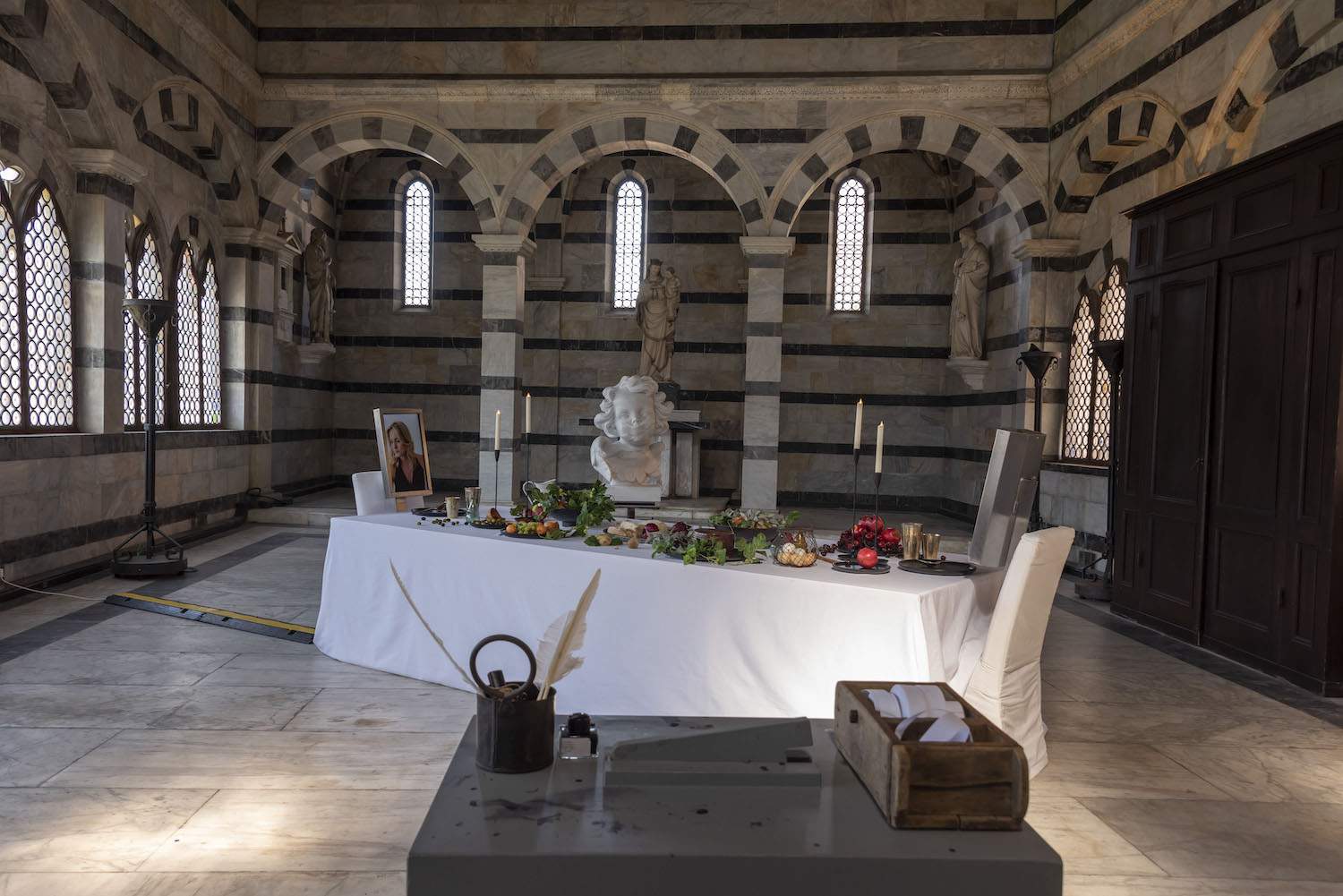Pisa, a table set inside the church of Santa Maria della Spina
Starting Friday, July 9, visitors to the church of Santa Maria della Spina in Pisa will find a table set inside: it is the installation by American artist Rachel Lee Hovnanian (Parkersburg, 1959) for the exhibition Dinner For Two. Art Gathering Souls, which will remain open until Aug. 22. For the 13th-century church of Santa Maria della Spina, Lee Hovnanian devised a specific artistic path to respect the “genius loci” of the historic Gothic context, seeking to combine conceptual elaboration, design abstraction and technical know-how. The exhibition, curated by Annalisa Bugliani and Alessandro Romanini, focuses on a multimedia installation titled Dinner for Two conceived by the artist in 2012, developed later, which focuses on issues of close relevance such as the danger inherent in the excessive use of technological media of communication, increased in this historical conjuncture marked by pandemic social distancing, and the analysis of related relational dynamics. It is a format created to adapt to the various exhibition venues, according to site-specific dynamics, and is presented to the viewer in the Pisan venue in the form of a sumptuously set table, connoted by an arrangement of food and furniture inspired by the concept of accumulation typical of mass society and decadent nuances.
At the same time, the table is meant to be an archetypal symbol of conviviality, the fulcrum of human interactions and the attacks that these relationships suffer in the context of contemporary society. The table-installation houses two diners in the form of a digital video presence, who, despite the ritual sharing of the meal, are immersed in a silent isolation interrupted only by the notification sounds of smartphones. Complementing the multimedia installation, we find an expertly crafted Carrara marble bust titled Shhh that depicts an angel with two pieces of tape covering his mouth to symbolize the various forms of censorship, explicit and implicit, enacted by today’s hyper-connected society. The sculpture alludes to the various ways in which censorship can cause emotional and psychological turmoil for its victims and witnesses.
“The reluctance to speak our truths,” explains Rachel Lee Hovnanian, “can stem from the fear of being scrutinized, disbelieved or even vilified, which has led countless people to remain silent. Therefore, we are left to judge between reality and fiction based on perception, preconceived notions, and ultimately beliefs.”
“Since the origins of her artistic career, Rachel Hovnanian’s work,” explain curators Annalisa Bugliani and Alessandro Romanini, “has militantly focused on the drifts caused by the excessive and distorted use of technological means of communication, which provoke in subjects a ’narcissistic stupor,’ and on the fragility structural of society undermined by unbridled hedonism, characteristic of our media civilization; phenomena deflagrated in a macroscopic way with the recent pandemic and related social distancing.”
The American artist’s works are elaborate reflections, condensed into plastic form, installations in which studies and analyses converge, bringing together from sociology to art history, anthropology to mass media studies, from Herbert Marcuse, Jean Baudrillard and Marshall McLuhan to Zygmunt Bauman. The exhibition itinerary is designedly integrated by a twofold process; one involving the dimension of “spectatorial activation with a cathartic function” that involves the viewer, asking him or her to formulate in written and anonymous form so-called “Negative Thoughts,” negative thoughts of any nature that afflict him or her and entrust them to a container placed in the exhibition itinerary. At the end of the exhibition, the artist will organize in the form of a “time based,” performative, apotropaic action, the enfranchisement from these “Negative Thoughts” by gathering the paper media in the form of a kite (which will have the effigy of the sculpted angel present in the church) that will be set free in the sky , to disperse and dissolve the load of negativity.
The American artist, in this way, intends to stimulate in visitors an active attitude, freed from the passive contemplation characteristic of mass media, by inserting a spectatorial space in the work, bringing to the forefront, once again, the cathartic and ritual ancestral power of art and culture, to guide us through the winters of the spirit and the separation of bodies and souls (to which the exhibition’s subtitle alludes). Rachel Lee Hovnanian “thus continues on her path of relentless research and elaboration, managing to bring together once again, extreme technological innovation and its effects on the individual and the genetic and archetypal components of the human being, the true protagonist of her exhibitions, bringing out the saving power of art,” the curators conclude.
The exhibition will be open July 9 through Aug. 22 daily from 10 a.m. to noon and 5 to 8 p.m. For information: www.rachelleehovnanian.com, info@theprojectspace.it.
Rachel Lee Hovnanian, born in 1959 in Parkersburg, West Virginia and raised in Houston, Texas, is an artist whose multidisciplinary practice explores the complexities of modern feminism, ideals of perfection and the effects of media on the collective consciousness. Hovnanian received her Bachelor of Fine Art degree from the University of Texas at Austin. He has since exhibited in solo and group exhibitions in the United States, Asia, Europe and the Middle East. His most recent exhibitions were Open Secrets, shown in Italy at the Palazzo Mediceo in Seravezza (July-October 2019) and Vision, a group show at the Southampton Art Center in New York (2020), Dinner for Two in the Church of San Cristoforo in Lucca (2020). His works are present in the collections of private individuals, companies and museums.
 |
| Pisa, a table set inside the church of Santa Maria della Spina |
Warning: the translation into English of the original Italian article was created using automatic tools. We undertake to review all articles, but we do not guarantee the total absence of inaccuracies in the translation due to the program. You can find the original by clicking on the ITA button. If you find any mistake,please contact us.




























